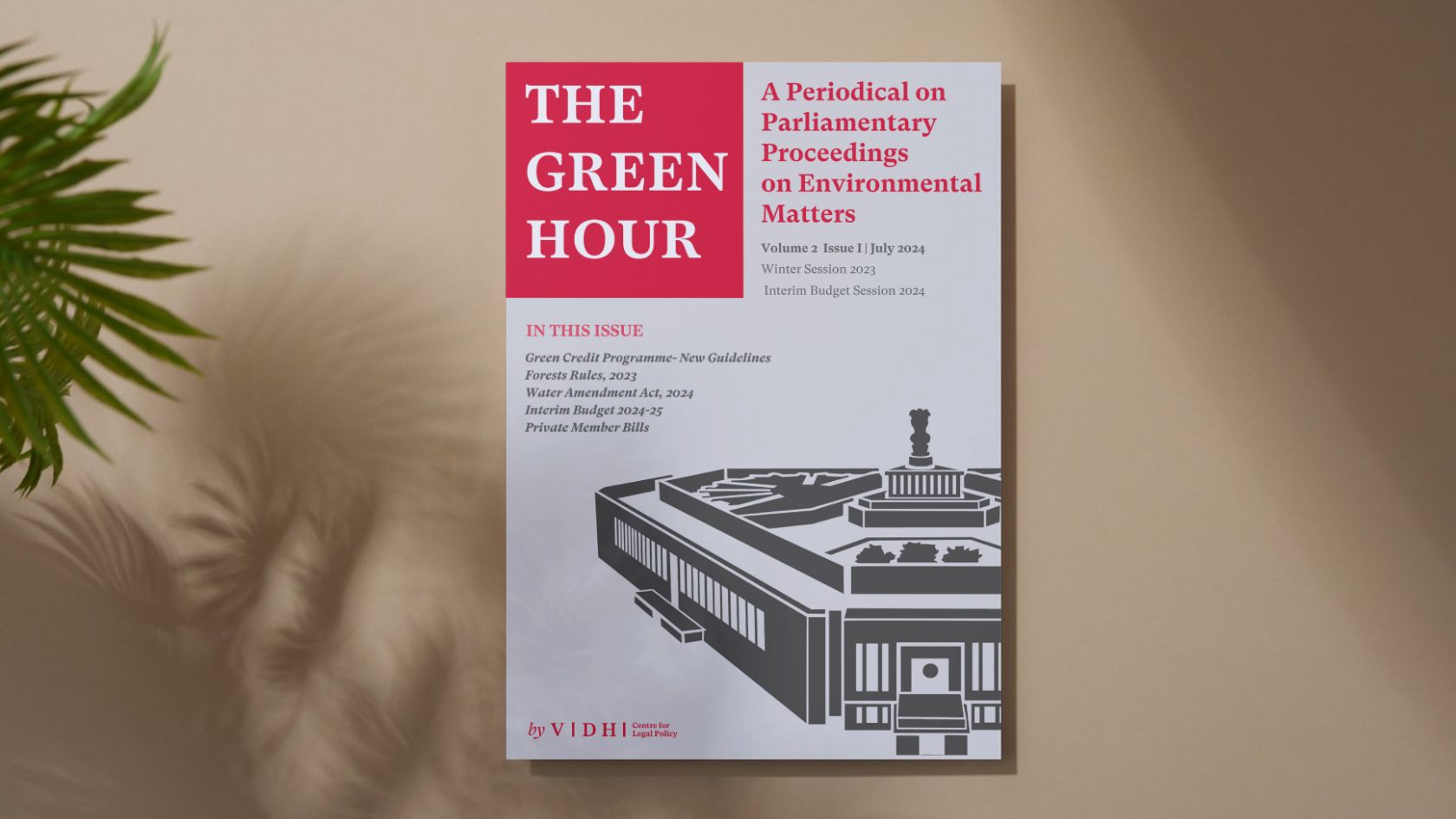
Forestation on Private Land in Karnataka
An assessment of the legal provisions governing forestation on private land in the State
An assessment of the legal provisions governing forestation on private land, prima facie, shows that no prior legal permission is required by the landowner to grow forests. However, there are legal consequences once a forest is grown on non-forest land. This entails an understanding of how forests are defined and protected under various regulations and court orders, especially on non-forest lands where forests are grown by private parties.
Frequently Asked Questions
- Are forests governed by the Central Government or State Governments in India?
Being in the ‘concurrent list’ of the Indian constitution, both Centre and State have powers to legislate on matters related to forests. Therefore, a forest is governed not only by central laws, but also by several state specific legislations.
- Does a private party need legal permission to grow a forest on their land?
No, a private party does not need legal permission to grow a forest on their land.
- How are forests defined? Is there any standard definition of forests in India?
There is no standard legal definition of forests in India. The ambiguity around the legal definition of forests has been a contentious issue that has been dealt with by the Supreme Court in a number of cases. The Supreme Court in the T N Godavarman Thirumulpad v. Union of India and Others (Godavarman case) defined ‘forest’ to include any piece of land that resembles the dictionary meaning of forest for the purpose of the Forest Conservation Act, 1980.
- Why is there no standard legal definition of forests in India?
There is no standard definition of forests in India as there cannot be any uniform criteria to define forest which can be applicable to all forest types in all State/Union Territories. The Forest Advisory Committee of the Ministry of Environment, Forest & Climate Change has stated that States do not have to take the Centre’s approval to define what constitutes a forest.
- Does the definition of forest as laid down in the Godavarman case include private forests in Karnataka?
Yes, the definition of ‘forest’ as laid down in the Godavarman case was inclusive of private forests.
- What is a Forest Clearance and who issues it? Are Forest Clearances mandatory to obtain for all private forests in Karnataka?
Forest clearance is an approval given by the Ministry of Environment, Forest & Climate Change for the diversion of forest areas for non-forest purposes under the Forest Conservation Act, 1980. While diversion of notified forests and lands recorded as ‘forest’ require prior forest clearance, privately owned lands that are not recorded as forests do not need a forest clearance in Karnataka.
- Do you need a Forest Clearance from the Central government for privately owned lands not recorded as forests in Karnataka?
No, you do not need a forest clearance from the Central government for privately owned lands not recorded as forests in Karnataka.
- What are the implications of the Godavarman case in Karnataka?
The expert committee constituted by the government of Karnataka in compliance with Godavarman case reiterated that the provisions of the Forest Conservation Act, 1980 would apply clearly to all forests irrespective of their ownership or classification.
- How does the state government classify ‘forests’ in Karnataka?
The Karnataka government categorises the ‘forests’ into two categories- “notified forests” and “deemed forests”.
- Notified forests are those areas that have been notified as per the Karnataka Forest Act 1963 and the Karnataka Forest Rules 1969.
- Deemed forests are those areas that have not been notified, but recorded as forests in the Government records. They are lands that have the characteristics of forests, irrespective of the ownership.
- What are the types of forest land that may be privately owned?
The types of land that may be privately owned are:
- Notified forests which are forest land notified as under the Karnataka Forest Act, 1963.
- Deemed forests which are not notified as forests but are recorded as ‘forests’ in the Government Record.
- Privately owned lands that are not notified as forests or recorded as ‘forest’ in the Government Record.
- What are the key regulations on felling of trees in Karnataka?
The key regulations on felling of trees in Karnataka are:
- The Karnataka Forest Act, 1963 governs the management of forests for Notified Forests. The Act requires the owners to obtain a felling permit from the Karnataka Forest Department to cut, collect or remove trees from a notified private forest.
- The Karnataka Preservation of Trees Act, 1976 governs the management of plantations for private lands not notified as forests. The Act mandates permission from the Karnataka Forest Department to fell trees in some districts and administrative units with certain exemptions.
- Where is the restriction on felling of trees in non-forest areas applicable (including plantations) in Karnataka?
The restriction on felling of trees under the Karnataka Preservation of Trees Act, 1976 is applicable only in the rural areas of 9 districts, 47 talukas and 65 municipal areas notified by the State Government. The restrictions do not apply on felling of trees for bonafide use of a family for utilizing timber up to 2.8 cubic meters, 100 poles, 100 bamboo and 5 tons of firewood in any calendar year.
- What are the areas that are exempted from the restriction on felling of trees and compulsory plantation under the Karnataka Preservation of Trees Act, 1976?
The restrictions on felling of trees and compulsory plantation of trees in the notified districts and talukas are exempted for Reserved Forests; lands managed by Horticulture Department or the University of Agricultural Sciences; and lands cultivated with coffee, tea and rubber wherein the number of plants is not less than 750 per hectare in the case of coffee and tea; and 225 in the case of rubber
- When does the State Government have the power to take over management of private forests in Karnataka?
The Section 39 of the Karnataka Forest Act, 1963 empowers the State government to regulate and prohibit certain activities for special purposes such grazing, maintenance of water resources, preservation of soil, protection from storms, etc.
The Government also has the power to take over the management of forests under Section 43 of the Karnataka Forest Act, 1963 in the following circumstances-
- in case of neglect or wilful disobedience to any regulation or prohibition by the owners
- when it appears to the State Government that it is necessary for the purpose of preservation and protection of the forest in public interest.
Section 43 of the Karnataka Forest Act, 1963 allows the Government to take over the management of such land on the request of the owner by an application in writing to the State Government where it is expedient in public interests to preserve the forest.
- Can agricultural land be purchased and utilised for forestation? Is it a simple process?
Yes, agricultural land can be purchased and utilised for forestation. However, it is a complicated process given the existing legal framework which grants discretionary powers to the Tehsildar, and because it is not clear on whether lands may be purchased expressly for the purpose of forestation.
- What are the restrictions on using agricultural land for forestation?
There is a mandatory requirement to cultivate lands on agricultural lands. If the occupant of the land fails to cultivate it consecutively for three years, the land may be disposed of by the State under the Karnataka Land Reforms Act, 1961. However, the Act grants the Tehsildar powers to condone the failure to cultivate for ‘sufficient reasons’.
- What are the restrictions placed on lands classified as an Eco Sensitive Zones?
Eco-Sensitive Zones(ESZ) are areas around National Parks and Wildlife Sanctuaries which are notified by the Central Government under Environment (Protection) Act 1986 to act as a buffer zone. While there may not be any prohibition on forestation within the ESZ, individual ESZ notifications lay down the specific details of activities that may be permissible within the ESZ area. For instance, all development activities such as mining, industrial activities, etc. may be prohibited within an ESZ. The construction of houses or commercial activities within privately owned lands may also be regulated in the ESZ Notification for the particular Protected Area in question.
Read the relevant laws here.
The Forest (Conservation) Act, 1980
The Karnataka Forest Rules, 1969
The Karnataka Forest Act, 1963
The Karnataka Preservation of Trees Rules, 1977
Karnataka Land Reforms Act, 1961
The Karnataka Preservation of Trees Act, 1976





